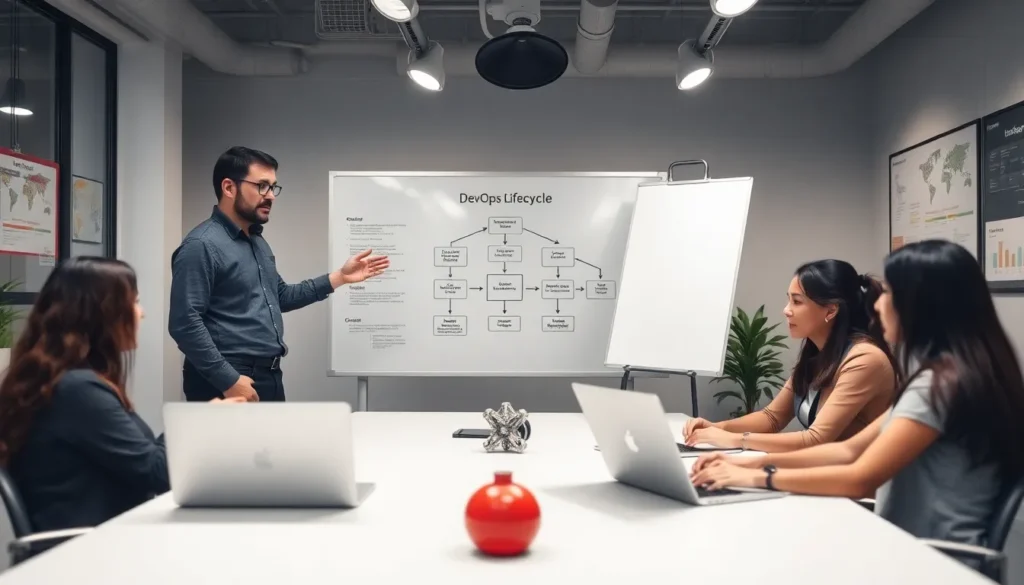In the fast-paced world of software development, the DevOps lifecycle is like the secret sauce that turns chaos into harmony. Imagine a well-orchestrated symphony where developers and operations teams play in perfect unison, delivering high-quality software faster than you can say “continuous integration.” It’s not just a buzzword; it’s a game changer that transforms how teams work together.
Table of Contents
ToggleOverview of DevOps Lifecycle
The DevOps lifecycle plays a crucial role in modern software development. It integrates development and operations to enhance efficiency and improve delivery.
Definition of DevOps
DevOps represents a set of practices that combine software development and IT operations. This approach aims to shorten the systems development lifecycle while delivering features, fixes, and updates frequently. Collaboration between cross-functional teams fosters a culture of accountability, where developers and operations professionals work together. By utilizing automation tools and continuous feedback, teams can respond swiftly to changing requirements.
Importance of DevOps Lifecycle
The DevOps lifecycle enables teams to streamline processes, increasing productivity. It reduces the time to market for new software features, allowing businesses to compete more effectively. Enhanced collaboration improves communication between teams, preventing silos that slow down progress. Continuous integration and continuous deployment practices play a significant role here, ensuring faster iterations and higher-quality software. Adopting the DevOps lifecycle ultimately leads to increased customer satisfaction, as teams can deliver reliable products that meet user needs efficiently.
Phases of the DevOps Lifecycle

The DevOps lifecycle consists of multiple phases that enhance collaboration and efficiency in software development and operations.
Planning
Planning sets the foundation for the DevOps lifecycle. Teams collaborate to define project goals and identify requirements. This phase typically involves assessing user needs and aligning them with business objectives. Moreover, clear objectives lead to streamlined workflows. Utilizing tools for backlog management and task tracking fosters transparency among team members. Effective planning ultimately reduces risks and aligns expectations throughout the development process.
Development
Development transforms ideas into functional software. In this phase, developers write code and build features in iterations. Incorporating best practices such as version control ensures efficient collaboration and code management. Code reviews further enhance quality and maintainability. Tools like IDEs and CI/CD pipelines automate builds, making it easier for developers to focus on writing code. Regular communication between development and operations teams supports alignment and addresses issues early in the lifecycle.
Testing
Testing is crucial for validating code quality and functionality. This phase often employs automated testing frameworks to ensure rapid feedback and comprehensive test coverage. Various types of testing, such as unit, integration, and performance testing, identify defects before deployment. Continuous testing practices integrate seamlessly with development, promoting early detection of bugs. An emphasis on collaboration between testers and developers cultivates a shared responsibility for product quality.
Deployment
Deployment involves making the software available to users. This phase can utilize automated deployment tools to streamline the process and reduce human error. Frequent deployments promote gradual feature releases and quick user feedback. Rollback strategies are often established to manage issues during or after deployment. Close collaboration with operations teams ensures that the deployment occurs smoothly, enabling faster response times to user needs.
Monitoring
Monitoring tracks the performance of applications and infrastructure post-deployment. Gathering metrics and logs allows teams to detect anomalies and assess user experience. Effective monitoring tools provide real-time insights that inform ongoing improvements. Continuous feedback loops foster a culture of accountability, encouraging teams to address issues proactively. Analyzing data helps teams understand usage patterns and informs future development efforts.
Key Principles of DevOps Lifecycle
DevOps lifecycle principles emphasize collaboration and efficiency in software development. Focus on key practices like continuous integration, delivery, and feedback to improve overall processes.
Continuous Integration
Continuous integration involves frequently merging code changes into a shared repository. Automated builds and tests validate each integration, ensuring immediate detection of issues. Development teams benefit from early bug detection, enabling swift fixes. Moreover, this practice promotes a culture of shared responsibility among members, enhancing team cohesion. Regular integration reduces the complexities associated with later stages of development. Tools like Jenkins or Travis CI streamline this process, further ensuring code quality.
Continuous Delivery
Continuous delivery extends the principles of continuous integration. This practice allows teams to deploy code changes to production automatically after passing tests. It enables quick and reliable software releases, meeting user demands effectively. Automation tools like Spinnaker or AWS CodePipeline facilitate this seamless transition from development to deployment. Additionally, teams gain the capability to release updates frequently, enhancing customer satisfaction. By prioritizing this principle, organizations create a more responsive development environment.
Continuous Feedback
Continuous feedback focuses on gathering insights from users and systems throughout the software lifecycle. This principle establishes mechanisms for capturing user experiences and performance metrics. As a result, teams can address issues proactively before they escalate. Employing tools for monitoring and analytics fosters swift data-driven decisions. Incorporating feedback loops into every lifecycle phase cultivates an adaptive mindset within teams. Ultimately, this ongoing dialogue between users and developers enhances overall software quality and aligns products with user needs.
Tools and Technologies in DevOps Lifecycle
DevOps heavily relies on a variety of tools and technologies to streamline its lifecycle. These resources enhance collaboration and efficiency, driving high-quality software delivery.
Popular Tools
Git, Jenkins, and Docker represent popular tools in the DevOps landscape. Git facilitates version control, allowing teams to track changes efficiently. Jenkins automates the build process, enabling continuous integration and delivering quick feedback on code changes. Docker streamlines application deployment by containerizing software, ensuring consistency across environments. Kubernetes complements Docker by managing these containers at scale, simplifying orchestration and scaling needs. Other tools like Ansible and Terraform automate provisioning and configuration management, fostering a smoother deployment process.
Automation in DevOps
Automation plays a crucial role in the DevOps lifecycle. Continuous integration and continuous deployment (CI/CD) automate testing and deployment tasks, reducing manual effort significantly. Testing frameworks like Selenium automate quality assurance processes, ensuring faster feedback loops. Automated monitoring tools such as Prometheus and Grafana provide real-time insights into application performance, allowing teams to respond swiftly to issues. Infrastructure as code (IaC) tools like Terraform enable teams to manage infrastructure through scripts, minimizing errors and improving consistency. By leveraging automation, organizations streamline operations, decrease time to market, and enhance overall software quality.
Challenges in Implementing DevOps Lifecycle
Implementing the DevOps lifecycle can present several challenges that teams must navigate effectively.
Cultural Shifts
Adopting DevOps requires significant cultural changes within organizations. Teams may encounter resistance due to ingrained silo mentalities between development and operations. Leadership plays a crucial role in fostering a collaborative environment that encourages open communication. Building trust among team members helps streamline collaboration, enabling smoother transitions between phases. Emphasizing shared responsibilities promotes accountability, ultimately enhancing team performance.
Tool Overload
Integrating numerous tools can complicate the DevOps lifecycle. Teams might struggle with selecting and managing an adequate toolset amid various options available in the market. Increased complexity impacts efficiency and often leads to confusion regarding best practices. Selecting tools that align with team objectives ensures effective utilization without overwhelming team members. Prioritizing essential tools streamlines processes while maximizing productivity.
Security Concerns
Security remains a critical aspect of the DevOps lifecycle. Rapid deployment cycles might lead to overlooked vulnerabilities, increasing risks for organizations. Implementing security practices throughout each phase addresses potential threats proactively. Incorporating automated testing ensures that security measures are enforced consistently, safeguarding applications from breaches. Establishing a security-first mindset supports long-term success in the DevOps approach.
Embracing the DevOps lifecycle is essential for organizations aiming to enhance their software development processes. By fostering collaboration between development and operations teams, it streamlines workflows and accelerates delivery. Each phase of the lifecycle contributes to a culture of accountability and responsiveness, ensuring that teams can adapt to changing requirements swiftly.
As businesses navigate the complexities of modern software development, leveraging tools and practices within the DevOps framework can lead to improved product quality and customer satisfaction. Addressing challenges like cultural resistance and security concerns is crucial for successful implementation. Ultimately, organizations that adopt the DevOps lifecycle position themselves for sustained growth and competitive advantage in an ever-evolving digital landscape.






